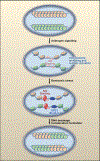The dangers of transcription
- PMID: 20005797
- PMCID: PMC6312720
- DOI: 10.1016/j.cell.2009.11.037
The dangers of transcription
Abstract
Transcription is obviously essential, but even a good thing can be dangerous at times. In this issue, Lin et al. (2009) provide evidence that binding of the transcription machinery may predispose genome regions to breakage and translocations that may lead to cancer.
Figures

Comment on
-
Nuclear receptor-induced chromosomal proximity and DNA breaks underlie specific translocations in cancer.Cell. 2009 Dec 11;139(6):1069-83. doi: 10.1016/j.cell.2009.11.030. Cell. 2009. PMID: 19962179 Free PMC article.
References
Publication types
MeSH terms
Substances
Grants and funding
LinkOut - more resources
Full Text Sources

